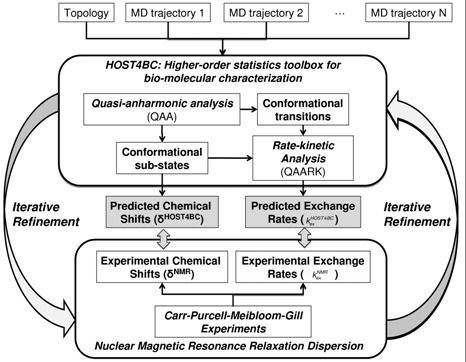Software developed in the group: Please click on tabs for more details
- 1. HOST4BC: Conformational sub-states analysis (Joint work with Dr. Chennubhotla, and Dr. Doucet)
- 2. VigyaanCD: Bio/chemical software workbench
- 3. GPU LAMMPS: GPU-enabled version of LAMMPS for biomolecular simulations
HOST4BC: Higher Order Statistical Toolbox for Biomolecular Characterization

VigyaanCD: Bio/chemical software workbench
Vigyaan is an electronic workbench for bioinformatics, computational biology and computational chemistry. It has been designed to meet the needs of both beginners and experts. VigyaanCD is a live Linux CD containing all the required software to boot the computer with ready to use modeling software.
At present the following ready to use software comes on VigyaanCD: Arka/GP, Artemis, Bioperl, BLAST (NCBI-tools), ClustalW/ClustalX, Cn3D, EMBOSS tools, Garlic, Glimmer, GROMACS, Ghemical, GNU R, Gnuplot, GIMP, ImageMagick, Jmol, MPQC, MUMer, NJPlot, Open Babel, Octave, PSI3, PyMOL, Ramachandran plot viewer, Rasmol, Raster3D, Seaview, TINKER, XDrawChem, Xmgr and Xfig. GNU C/C++/Fortran compilers and additional Linux tools (such as ps2pdf) are also available.
VigyaanCD also provides tools required to compile and install other applications (from source). Therefore, making testing of 'Linux' applications possible on computers with other OS.
Visit VigyaanCD project web-site for more details: http://www.vigyaancd.org/

Download VigyaanCD VigyaanCD v1.0 size: 668651520 bytes (639 MB) md5sum: 834a4f1af53758dc1a597caf2ad27cb3
USA 1, California HTTP: http://www.vigyaancd.org/download/VigyaanCD-v1.0.iso
USA 2, Oak Ridge TN HTTP: http://www.vigyaancd.ornl.gov/download/VigyaanCD-v1.0.iso
GPU LAMMPS: GPU-enabled version of LAMMPS for biomolecular simulations
Our GPU-LAMMPS for biomolecular simulations is also available under Open Source Software model. The software is capable of running simulations based on CHARMM and AMBER force-fields and can be run with CHARMM/AMBER topology, coordinate files (after conversion with provided scripts). It is capable of running on single workstations as well as scalable GPU-enabled Linux clusters.
A copy of the code is available here. This tarball gpulammps.tar.gz will unzip into a directory called USER-BIO-GPU. Note that you will also need to download LAMMPS from the project web-site (http://lammps.sandia.gov/). See the README files for instructions (a copy is also provided below).
# INSTALLATION INSTRUCTIONS #
The files in this directory are a user-contributed package for LAMMPS. Please contact Pratul Agarwal (agarwalpk@ornl.gov), if you have questions regarding the code or for example scripts.
This package implements a CUDA enabled version of the pair functions lj/charmm/coul/charmm and lj/charmm/coul/long. This work is currently being merged into the main gpu trunk, but is provided here in the interim.
To install this package, place the directory USER-BIO-GPU into the lammps/src directory if it is not already there. Then:
cd [your lammps directory]/src
make no-all
make yes-molecule
make yes-kspace
make yes-user-bio-gpu
make cuda
Be aware that you may have to edit the file MAKE/Makefile.cuda if your default installations differ from those of the authors.
Example output files are available in the sub-directories of USER-BIO-GPU/bio-bench.
This software includes code developed by the previously mentioned authors at Oak Ridge National Laboratory.
# INSTALLATION DETAILS #
The files in this directory are arranged according to the usage guidelines for user contributed code for LAMMPS. The file 'Install.sh' is used to copy the necessary files into the 'lammps/src' directory upon execution of the command 'make yes-user-bio-gpu'. This package may be uninstalled from the same directory using the command 'make no-user-bio-gpu'. The top level directory contains files that implement the GPU kernels and their associated helper functions. There is also a specific Makefile. In addition, there are some files that are owned by LAMMPS that must be modified. In order to distinguish them, they are placed in a sub-directory called 'core-files/'. When the USER-BIO-GPU package is installed, the original versions of these files are copied to the directory 'orig-files/'. If this package is un-installed, these files will be restored.